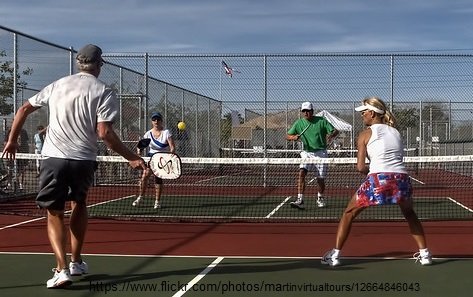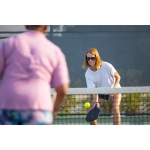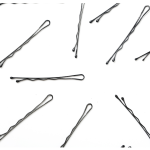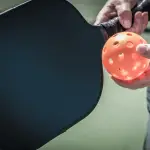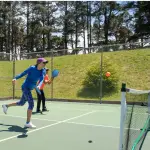If you’ve played or watched tennis doubles, then you know the key to the game is to control the net. Pickleball strategy is similar to tennis with the team controlling the net the one most likely to win the point. In the case of Pickleball, however, controlling the net means controlling the area just behind the no-volley-zone or kitchen line. Many times when you see beginner’s play, they tend to stay at the baseline or get stuck in the area between the baseline and kitchen line. This is called no man’s land. You will find if you spend much time in this area it is difficult to win points.
Knowing the importance of the net game now, the question is how to be successful in getting to the net as part of your Pickleball strategy in doubles. Let’s first talk about the serve and serve return in Pickleball as the strategy is not the same in tennis where you are trying to hit an ace or winner on these two shots.
Serving
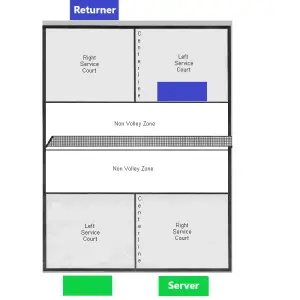
In Pickleball, play starts with the serving team at the baseline. The returning team is staggered. See the picture above for the positions of the players on the serve with the blue rectangles representing the team returning the serve and green rectangles representing the serving team. This means the person returning the serve is at the baseline while their partner stands just behind the kitchen line. The person at the kitchen line should be within an inch of the line, not a few inches behind as this puts the returning team at a disadvantage. I’ll discuss this more later.
The server in Pickleball only gets one chance to put the ball in play. Even professional players do not try to ace their opponent as it is very difficult to be consistent with the serve if going for a winner. The goal of the server is to hit the ball as deep as possible to the weaker hitting side of the opponent. For right-handed players, this is usually to their left or to their backhand. With the ball being served deep to your opponent, you have a greater chance of pinning them to the baseline. This makes it more difficult for the serve returner to get to the kitchen line quickly.
The goal of Pickleball strategy is to hit every serve in. This means the serve is very vanilla although you do see people putting spin on the serve. At lower levels, the spin can create a weak return but at higher tournament levels the serve returner can easily handle the spin and pace of the ball.
Remember the key to the Pickleball serve is not to be fancy but to be consistent. Also stay away from hitting short angles on the serve. The result is usually a short angle back to you which can be very difficult to return. I mistakenly hit a short angled serve to a better player and I quickly lost the point as he hit a short angle back that I could not return since I was at the baseline.
Serve Return
The person returning the serve should employ the same strategy as the server. Hit the ball as deep in the court as possible. An effective Pickleball strategy is to hit the ball deep into the middle of the court so as to cause confusion between the serving team on who will hit the third shot.
The serve return team does not need to worry about how high over the net they hit the ball. This is because the serving team must let the ball bounce before they hit it. In fact, if the server hits a deep ball to you, hitting the ball high over the net gives you more time to get to the kitchen line. This is a very effective Pickleball strategy in getting to the net faster. Hitting the ball low and hard decreases the time you have to move forward and you may get stuck in no-mans land.
Third Shot
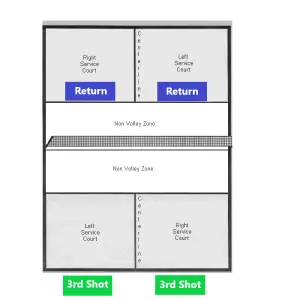
After the serve and serve return, the serving team (green rectangles) hits the ball on the third shot from the position in the picture above. The ball must bounce before the serving team hits the third shot. This shot is the key to getting to the net for the serving team. The best shot to hit is a drop shot or third shot drop. This means the ball is hit into the kitchen so the serving team can move to the net as it is difficult for the returning team to be offensive with a ball that bounces in the kitchen.
The third shot drop is a shot unique to Pickleball and it can be difficult to execute. The arch of the shot should crest on the serving side around the kitchen line. If the shot is hit too flat, it will go in the net. If the shot is hit too high, the returning team can hit an offensive valley that pins the serving team deep. The closer you hit the ball to the net, the more effective it is especially if you angle the shot toward your opponents’ backhand.
How to Practice the Third Shot Drop
When I started playing Pickleball, I had never heard of a third shot drop. I quickly learned the importance and started practicing the shot on a regular basis as it can be tricky to master. The best way to practice the third shot drop is to start at the kitchen line and dink to your practice partner (who should also be standing at the kitchen line). A dink is a shot that bounces in the kitchen.
Once you feel comfortable dinking from the kitchen line, move back in the court so you are midway between the kitchen line and baseline. Continue dinking from this location until you are comfortable. Then move back to the baseline and continue hitting the same shot. This is the same as the third shot drop. If you have trouble controlling the ball, have your practice partner stay at the kitchen line and then you can move back to mid-court and the baseline.
Since the third shot drop is unique to Pickleball strategy, you may not see many beginning and intermediate players execute it. Instead they will drive the ball at their opponents’ at the net. At times, this shot can be effective if you are playing weaker opponents. Against better players, however, you will be pinned at the baseline as they will volley the drive shot deep in the court. This puts the serving team at a disadvantage since they are not able to move to the net. The point is learn to hit a third shot drop. This allows you mix things up and get to the next more easily.
Dink Game

The dink game or soft game is another unique aspect of Pickleball strategy. The dink is a shot hit softly that goes over the net and lands in the kitchen. All four players are just behind the kitchen line when hitting the shot as illustrated in the picture above with the green rectangles representing one team and the blue rectangles representing the other team.
At lower levels of play, the point can be won just by hitting dinks more consistently than your opponent. At higher levels, the reason for dinking is to set up a future shot so you can be offensive. Your opportunity to be offensive is when your opponent hits a dink or volley high over the net. Then you can attack the high shot and try to end the really by hitting at your opponent’s feet or hitting the ball by the other team.
Most beginners and intermediate players struggle with the dink game. They have a hard time controlling this shot and are not patient so they try to hit an offensive shot too soon. Advanced players can have very long rallies just by dinking back and forth because they can consistently place the ball. I’ve had many long dink rallies in Pickleball while playing agains the club tennis pro. In one, we both were hitting the ball so low over the net we both clipped the net with the ball going over to the opponent before we had a chance to be offensive.
The goal of dinking is to hit the ball as low as possible over the net while not making a mistake. The closer the ball lands to the net or to the sideline, the more difficult it is to return. If a ball is hit out wide to the sideline, the doubles team should work together to cover the court. This means the person who is not hitting the ball should shuffle over near the center of the court to prevent the opponent from hitting a shot down the middle that neither player can get to.
The Erne
Shots hit out wide can be countered with a shot called the Erne. This is an advanced shot which can be illegal if not performed correctly. The person setting up for the Erne must move before their opponent hits the ball. Usually this involves jumping over the non-volley zone and establishing position outside the court. The reason for doing this is to turn a backhand into a forehand and to surprise your opponent with an offensive shot.
When hitting the Erne, the player can step into the non-volley zone on the way to a position outside the court. However, they must establish position outside of the court before they hit the Erne. I have to say I don’t think I have ever hit an Erne but it may be something I practice for the future as it can be very effective at higher levels of play.
Special Circumstances
Bangers
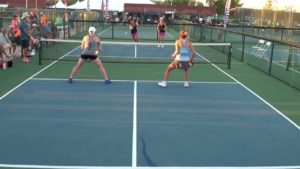
While hitting third shot drops and dinks are unique to Pickleball strategy, you often play former tennis players who like to drive the ball to you at the net. This type of player is referred to as a banger as you will see them wind up for a hard or drive shot from the baseline much like they do in tennis.
The best strategy against bangers is to force them to come up to the net. When my opponent drives the ball at me, I loosen my grip and hit a soft volley into the kitchen. While this puts my opponent at the net, bangers do not usually feel comfortable there so I have an advantage in the rally since I like to dink.
Playing a banger can be a challenge if you struggle with the fast pace of the ball. Still, you should maintain your position at the net. If you don’t feel comfortable hitting a soft volley, you can also send the ball deep into the court. Just remember, however, this is when the banger is comfortable as they will get to drive another ball at you. This is why the better play is to hit a short shot so they are forced to move forward.
Poaching
Poaching is a play more commonly used in tennis than Pickleball. However, Pickleball players can still use it to their advantage. Poaching occurs when you cross the center line to hit a ball on the other side of the line. In essence, you are taking a shot away from your partner.
This is not meant as a bad thing because poaching has its place in certain situations. The first occurs when your partner is deeper in the court than you are. If your opponent hits a high ball, it can be a good strategy to cross the center line and hit an overhead. Otherwise your partner gives up this offensive opportunity because they are too deep in the court.
Another situation where poaching is effective is when the other team rarely hits you the ball. This is a Pickleball strategy used when one player on a team is much better than their partner. In order for the stronger player to get involved in points, they may need to poach so they can end rallies and score points.
Lobs and Lob Coverage
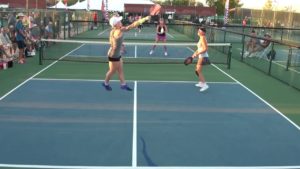
An effective shot in tennis is to hit a lob when your opponents are at the net. A lob can also be effective in Pickleball but remember Pickleball players are not as close to the net since they need to stand outside the kitchen to hit a volley. Also remember the court in Pickleball is not as long so you have to be very precise in hitting lob shots over your opponents’ head.
If you can disguise your lob so it is just a slight variation from your volley it can be effective. My partner in Pickleball often hits lobs as it is a shot she has mastered. At lower levels it can be very effective. At higher levels, our opponents may be surprised the first time she hits a lob. But after that they are looking for the lob so it loses its effectiveness over time.
When covering a lob that the other team hits, I like to get the lobs being hit over my head. Some people will say your partner should get the ball hit over your head because they have the better angle. But I believe this puts your team out of position with two players often on the same side of the court. Stick with getting the lobs hit over your head as this is more effective.
Playing Defense
Once you get into a rally in Pickleball, your goal is to hit the ball low over the net while not making a mistake. Unfortunately, it can be hard to execute this Pickleball strategy 100% of the time. In cases where your opponent hits an offensive shot, you may need to move back in the court to improve your chances of returning the ball. This scenario happens when your team hits a high ball over the net. If the ball is at your opponents shoulder or higher they can hit an overhead. The best way to counter their offensive shot is to move back in the court. Ideally both you and your partner should work in tandem by moving back together.
If you are successful in returning the overhead, you will want to work your way back up to the net. You can do this by hitting a third shot drop just like the serving team does. The third shot drop lands in the kitchen and essentially neutralizes your opponent’s ability to be offensive. Take advantage of this and move up to the net again.
Line Calls
Making line calls on close shots can be a challenge. I know as I have gotten older, my eye sight is just not as good. I do, however, help my partner to make line calls as sometimes it is difficult to both hit the ball and to make sure it is in bounds. When I make a line call on my partner’s side of the court, I like to be sure of the call as I don’t have the best angle when I’m on the other side of the court. If I can clearly see the ball is out, I’ll make the call. If the ball is questionable, I play on unless my partner calls it out. In friendly recreational games, you can also ask your opponent as sometimes they may have the best angle. For more information on line calls, check out the rules.

Summary
On the surface, Pickleball strategy is simple in doubles. Get to the net! The team controlling the net is most likely to win the point. While it can seem strange to hit third shot drops and dinks when you first start playing, it is an essential strategy to winning Pickleball as you play more skilled opponents. The best thing to do is to practice these shots so you feel comfortable executing good Pickleball strategy.

